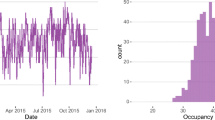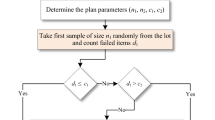Abstract
Phase-type distributions constitute a very versatile class of distributions. They have been used in a wide range of stochastic modelling applications in areas as diverse as telecommunications, finance, biostatistics, queueing theory, drug kinetics, and survival analysis. Their use in modelling systems in the healthcare industry, however, has so far been limited. In this paper we introduce phase-type distributions, give a survey of where they have been used in the healthcare industry, and propose some ideas on how they could be further utilized.
















Similar content being viewed by others
References
Asmussen S (1997) Phase-type distributions and related point processes: fitting and recent advances. In: Chakravarthy SR, Alfa AS (eds) Matrix-analytic methods in stochastic models, lecture notes in pure and applied mathematics, vol 183. Marcel Dekkar, New York, pp 137–149
Asmussen S (2003) Applied probability and queues, 2nd edn. Springer, Berlin Heidelberg New York
Asmussen S, Nerman O, Olsson M (1996) Fitting phase-type distributions via the EM algorithm. Scand J Statist 23:419–441
Asmussen S, Olsson M (1998) Phase-type distributions (update). In: Kotz S, Read CB, Banks DL (eds) Encyclopedia of statistical science update, vol 2. Wiley, New York, pp 525–530
Au L, Byrnes GB, Bain CA, Fackrell M, Brand C, Campbell DA, Taylor PG (2008) Predicting overflow in an emergency department. IMA J Manag Math (in press)
Bini DA, Latouche G, Meini B (2005) Numerical methods for structured Markov chains. Oxford University Press, Oxford
Bobbio A, Cumani A (1992) ML estimation of the parameters of a PH distribution in triangular canonical form. In: Balbo G, Serazzi G (eds) Computer performance evaluation. Elsevier, Amsterdam, pp 33–46
Cox DR (1955) A use of complex probabilities in the theory of stochastic processes. Proc Camb Philos Soc 5:313–319
Cumani A (1982) On the canonical representation of homogeneous Markov processes modelling failure-time distributions. Microelectron Reliab 22:583–602
Dempster AP, Laird NL, Rubin DB (1977) Maximum likelihood from incomplete data via the EM algorithm. With discussion. J R Stat Soc Ser B 39:1–38.
Erlang AK (1917–1918) Solution of some problems in the theory of probabilities of significance in automatic telephone exchanges. Post Off Electr Eng J 10:189–197
Fackrell M (2003) Characterization of matrix-exponential distributions. PhD thesis, School of Applied Mathematics, University of Adelaide, South Australia
Faddy MJ (1990) Compartmental models with phase-type residence-time distributions. Appl Stoch Models Data Anal 6:121–127
Faddy MJ (1993) A structured compartmental model for drug kinetics. Biometrics 49:243–248
Faddy MJ (1994) Examples of fitting structured phase-type distributions. Appl Stoch Models Data Anal 10:247–255
Faddy MJ (1995) Phase-type distributions for failure times. Math Comput Model 22:63–70
Faddy MJ (1998) On inferring the number of phases in a Coxian phase-type distribution. Commun Stat Stoch Models 14:407–417
Faddy MJ (2002) Penalized maximum likelihood estimation of the parameters in a Coxian phase-type distribution. In: Latouche G, Taylor P (eds) Matrix-analytic methods: theory and applications. World Scientific, Singapore, pp 107–114
Faddy MJ, McClean SI (1999) Analysing data on lengths of stay of hospital patients using phase-type distributions. Appl Stoch Models Bus Ind 15:311–317
Faddy MJ, McClean SI (2005) Markov chain modelling for geriatric patient care. Methods Inf Med 44:369–373
Faddy MJ, Taylor GT (2003) Stochastic modelling of the onset of bronchiolitis obliterans syndrome following lung transplantations: an analysis of risk factors. Math Comput Model 38:1185–1189
Gorunescu F, McClean SI, Millard PH (2002) A queueing model for bed-occupancy management and planning of hospitals. J Oper Res Soc 53:19–24
Gribbin JO, McClean SI (1990) Modelling the duration of spells of withdrawal from a female dominated labour force. J Appl Stat 17:369–381
Hampel K (1997) Modelling phase-type distributions. Honours Thesis, Department of Statistics, University of Adelaide, South Australia
He Q-M, Zhang H (2005) A note on unicyclic representations of phase type distributions. Stoch Models 21:465–483
Horváth A, Telek M (2000) Approximating heavy tailed behaviour with phase type distributions. In: Latouche G, Taylor P (eds) Advances in algorithmic methods for stochastic models. Notable Publications, Neshanic Station, pp 191–213
Horváth A, Telek M (2007) A canonical representation of order 3 phase type distributions. In: Wolter K (ed) Formal methods and stochastic models for performance evaluation, Lecture notes in computer science, vol 4748. Springer, Berlin Heidelberg New York, pp 48–62
Johnson MA (1993) Selecting parameters of phase distributions: combining nonlinear programming, heuristics, and Erlang distributions. ORSA J Comput 5:69–83
Latouche G, Ramaswami V (1999) Introduction to matrix analytic methods in stochastic models. SIAM, Philadelphia
Marshall AH, McClean SI (2003) Conditional phase-type distributions for modelling length of stay in hospital. Int Trans Oper Res 10:565–576
Marshall AH, Vasilakis C, El-Darzi E (2005) Length of stay-based patient flow models: recent developments and future directions. Health Care Manage Sci 8:213–220
McClean SI (1976) The two-stage model of personnel behaviour. J R Stat Soc Ser A 139:205–217
McClean SI, Faddy MJ, Millard PH (2005) Markov model-based clustering for efficient patient care. In: Proceedings of the 18th IEEE symposium on computer-based medical systems. IEEE, Piscataway, pp 467–472
McClean SI, Gribbin JO (1987) Estimation for incomplete manpower data. Appl Stoch Models Data Anal 3:13–25
McClean SI, Millard PH (1993) Patterns of length of stay after admission in geriatric medicine: an event history approach. Statistician 42:263–274
McLachlan GJ, Krishnan T (1997) The EM algorithm and extensions. Wiley, New York
Nelder JA, Mead R (1965) A simplex method for function minimization. Comput J 7:308–313
Neuts MF (1975) Probability distributions of phase-type. In: Liber amicorum Prof. Emeritus H. Florin, Department of Mathematics, University of Louvain, Louvain, pp 173–206
Neuts MF (1981) Matrix-geometric solutions in stochastic models: an algorithmic approach. The John Hopkins University Press, Baltimore
Neuts MF (1984) The abscissa of convergence of the Laplace-Stieltjes transform of a PH distribution. Commun Stat Simul Comput 13:367–373
Neuts MF (1989) Structured stochastic matrices of M/G/1 type and their applications. Marcel Dekkar, New York
Neuts MF (1995) Algorithmic probability. Chapman and Hall, London
Norris JR (1997) Markov chains. Cambridge University Press, Cambridge
O’Cinneide CA (1989) On non-uniqueness of representations of phase-type distributions. Commun Stat Stoch Models 5:247–259
O’Cinneide CA (1999) Phase-type distributions: open problems and a few properties. Commun Stat Stoch Models 15:731–757
Olsson M (1996) Estimation of phase-type distributions from censored data. Scand J Statist 23:443–460
Ross SM (1993) Introduction to probability models, 5th edn. Academic, San Diego
Schmickler L (1992) MEDA: mixed Erlang distributions as phase-type representations of empirical distribution functions. Commun Stat Stoch Models 8:131–156
Seneta E (2006) Non-negative matrices and markov chains, revised printing. Springer, New York
Shaked M, Shanthikumar JG (1985) Phase-type distributions. In: Kotz S, Johnson NL, Read CB (eds) Encyclopedia of statistical science, vol 6. Wiley, New York, pp 709–715
Vasilakis C, Marshall AH (2005) Modelling nationwide hospital length of stay: opening the black box. J Oper Res Soc 56:862–869
Xie H, Chaussalet TJ, Millard PH (2005) A continuous time Markov model for the length of stay of elderly people in institutional long-term care. J R Stat Soc Ser A 168:51–61
Acknowledgements
This research is supported in part by the Australian Research Council linkage grant number LP0349153.
Author information
Authors and Affiliations
Corresponding author
Rights and permissions
About this article
Cite this article
Fackrell, M. Modelling healthcare systems with phase-type distributions. Health Care Manag Sci 12, 11–26 (2009). https://doi.org/10.1007/s10729-008-9070-y
Received:
Accepted:
Published:
Issue Date:
DOI: https://doi.org/10.1007/s10729-008-9070-y




